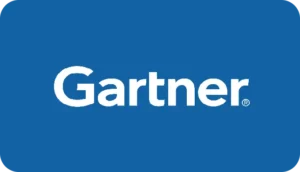As Gartner states, no single tool can help you accomplish hyperautomation. Newgen offers a low code digital transformation platform that integrates all tools and capabilities required to accomplish hyperautomation, through our low code process automation (BPM), contextual content services (ECM), and Omnichannel customer engagement (CCM) platform. Our platform helps you automate your processes holistically by bridging (process, content, and communication) silos in your organization.
What are the Common Challenges in Hyperautomation Journey?
Gap in identification of high-value automation use cases
Organizations often misdiagnose where to start, scale, or extend automation technologies. To be successful in your enterprise-wide optimization of processes, data, and people with hyperautomation technologies, you must complete a thorough evaluation.
No strategic roadmap
Often organizations do not have a long-term strategic roadmap for their hyperautomation journey or a plan to scale automation. They focus on tactical automation of routine processes, which help in the short term; however, it completely misses the overarching objective of hyperautomation
Lack of governance mechanisms
Organizations need a robust governance mechanism to integrate all the hyperautomation efforts and follow strategic technology trends. Strategic guidance built into the technology stack can go a long way in helping organizations reap business values from hyperautomation
Siloed approach to technology usage
Simply plugging your advanced technologies initiatives into the stack can lead to future scaling challenges. Technologies like AI or RPA can help accomplish automation goals in a local scope. Tying these technologies into a more extensive process backbone will deliver customer experience, speed, and other automation opportunities.
Hyperautomation: Technologies to Leverage
For hyperautomation to achieve its desired outcomes, an integrated approach with the right mix of advanced technologies is the key
Intelligent Process Automation (BPM)
Leverage, an intelligent process automation platform, and seamlessly orchestrate your end-to-end processes by connecting the people, bots, and systems involved in your operations. Operate, collaborate, and participate in business processes in a dynamic and remote environment without impacting the speed and quality of your services.
No strategic roadmap
Bring intelligence to your processes by leveraging AI and ML-based learning capabilities. Smoothly route tasks from inbound channels to the correct users, make smarter decisions and provide more context to your interactions with internal and external customers. Some of the capabilities under the AI and ML umbrella include NLP, pattern recognition, sequence labeling, sentiment analysis, natural language processing, optical character recognition (OCR), and digital process automation
Robotic Process Automation (RPA)
Increase automation capabilities, reduce turnaround times, bridge operational silos, and increase profitability and ROI by strategically automating mundane and repetitive tasks. Minimize the need for human intervention and effectively eliminate time-consuming bottlenecks by intuitively routing issues to the appropriate users
Process intelligence
Optimize your hyperautomation efforts by leveraging tools, such as advanced analytics and process mining, to gauge the health of your business processes, select the proper automation techniques, and make informed decisions
How Does Newgen Solve for Your Hyperautomation Needs?
To solve your hyperautomation needs holistically, a platform-based approach is imperative to streamline and maximize the capabilities of these technologies. The crux lies in bridging silos-both functional and technological-and creating an integrated platform strategy. Newgen’s digital transformation platform is the answer to all your hyperautomation needs. The platform enables-
Accelerated automation of end-to-end processes
The key technologies that form the fulcrum of hyperautomation tools and strategy are BPM, RPA, business rules management, decision management, and low code application platforms (LCAPs). These technologies can be further augmented by AI, ML, and cognitive automation to boost speed and intelligence. Newgen’s digital transformation platform ensures end-to-end automation that is complete in all three aspects (process, content, and communication) to make a significant customer impact
Continuous improvement and process agility
Newgen’s digital transformation platform helps achieve speedy business outcomes and continuous improvement with agile change management. Hyperautomation covers the entirety of the holistic process management (i.e., discover, analyze, design, automate, measure, monitor, reassess). So, while individual technologies play their part, a functionally robust process management platform with rapid application development capability forms the backbone of hyperautomation.
Lead with an Industry-recognized Platform
Organizations looking for an advanced content platform capable of scaling for heavy workloads and that need deployment flexibility and advanced automation and AI capabilities should consider Newgen.
The Forrester Wave™: Content Platforms, Q1 2025

Customers


















Customers Speak
All you need to know about Hyperautomation
Hyperautomation is the end-to-end automation of business processes using multiple technologies, RPA, AI/ML, low-code platforms, process mining, IDP, and workflow orchestration. It aims to eliminate manual work, accelerate operations, and create intelligent, scalable digital ecosystems across the enterprise.
Hyperautomation works by combining automation tools with AI to analyze processes, identify automation opportunities, execute workflows, and continuously optimize them. Hyperautomation software integrates data, decisions, and tasks across systems, enabling intelligent, autonomous, and scalable process automation.
Automation handles individual tasks using single tools like RPA. Hyperautomation orchestrates multiple technologies, AI, RPA, workflow automation, IDP, and low code, to automate entire processes end-to-end. It moves beyond task automation to intelligent decisioning, optimization, and enterprise-wide scalability.
Hyperautomation uses RPA, AI/ML, NLP, IDP, process mining, workflow automation, low-code platforms, chatbots, and decision engines. These technologies work together to automate tasks, decisions, data processing, and multi-step workflows with minimal human intervention.
Hyperautomation improves efficiency, reduces costs, eliminates manual errors, strengthens compliance, and accelerates decisions. It modernizes legacy workflows, enhances customer experience, and supports large-scale digital transformation. Businesses gain higher throughput, faster processing, and improved resource utilization.
Hyperautomation reduces manual work, automates repetitive tasks, speeds up workflows, and minimizes errors. It lowers labor costs, reduces rework, improves accuracy, and enables teams to focus on high-value activities. This results in measurable cost savings and higher operational efficiency.
Use cases include onboarding, claims processing, KYC, accounts payable, loan processing, order management, customer support automation, procurement workflows, inventory operations, and service requests. Industries like banking, insurance, healthcare, telecom, and manufacturing use hyperautomation to streamline complex, high-volume processes.
Effective hyperautomation software includes RPA platforms, low-code workflow tools, intelligent document processing (IDP), AI/ML engines, process mining tools, integration frameworks, chatbots, and decision management systems. The best stack combines automation, intelligence, and orchestration capabilities.
Intelligent automation integrates AI with automation to improve task efficiency. Hyperautomation goes further by combining multiple technologies, RPA, AI, workflows, IDP, low-code, and process mining, to automate entire end-to-end processes and continuously optimize them at enterprise scale.
Hyperautomation automates rule-based, repetitive, multi-step, and decision-heavy processes. Examples include claims, onboarding, invoicing, KYC, order processing, compliance checks, data entry, document verification, and customer service tasks across sectors with high transaction volumes.
Traditional automation solves isolated tasks. Hyperautomation connects multiple automation technologies to automate entire workflows, integrate systems, apply AI-driven decisioning, and continuously optimize processes. It delivers higher scalability, intelligence, and operational impact.
Industries with high-volume processes, banking, insurance, healthcare, government, telecom, manufacturing, logistics, energy. Hyperautomation helps handle documents, decisions, compliance steps, and repetitive workflows efficiently while improving accuracy and speed.
Common challenges include siloed processes, legacy systems, poor documentation, lack of skilled resources, integration complexities, and governance gaps. Successful hyperautomation requires clear strategy, standardization, process discovery, and a scalable automation framework.
Hyperautomation accelerates digital transformation by digitizing workflows, integrating data across systems, enabling AI-driven decisions, modernizing legacy processes, and reducing manual dependencies. It helps organizations scale faster and build more responsive, intelligent operations.
Choose hyperautomation software with strong RPA, AI/ML, workflow orchestration, low-code design, integration capabilities, analytics, governance, and security. The platform should support end-to-end automation, scalability, and alignment with enterprise goals.




















